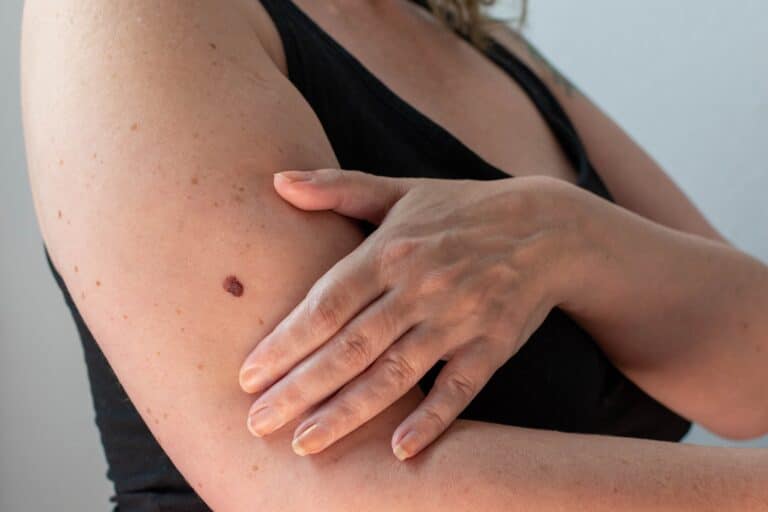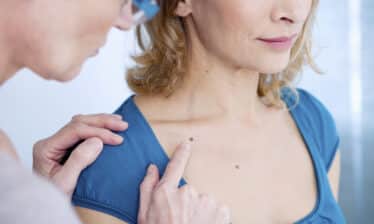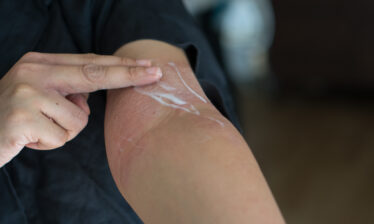Worried you might have skin cancer spots? You’re not alone. Skin cancer is the most common type of cancer nationwide. More than a million Americans live with melanoma, one of the most common forms of skin cancer, and an estimated 20% of Americans will develop skin cancer in their lifetimes.
Cancer is always scary, but skin cancer is highly treatable and survivable when caught early.
What Causes Skin Cancer?
Cancer happens when cells begin to divide out of control. Most skin cancers occur due to excess ultraviolet (UV) light exposure.
The sun exposes everyone to UV light. The more time you spend outdoors unprotected, the more exposure you accumulate. Over time, this can increase your risk of skin cancer.
Some people are at higher risk due to their skin type or medical history. Signs of elevated risk include:
- Lighter skin, eyes, and hair
- Skin that burns, reddens, or freckles easily
- A family or personal history of skin cancer
- Older age
The higher your risk, the more you need to watch for early signs of skin cancer. Catching skin cancer early improves your chances of a positive outcome.
Skin Cancer: What to Watch For
So, what does skin cancer look like?
In most cases, the telltale sign is a new or changing growth on your skin. These can look different depending on the type of cancer.
Basal Cell Carcinomas
A basal cell carcinoma, one of the two most common types of skin cancer, often looks like an ordinary skin growth. It can show up as:
- A reddish or pink growth with a dip in the center
- A scaly growth on or near the ear
- A sore that doesn’t heal or comes back
- A patch of irritated or scaly skin
- A round growth, often your natural skin color
- A shiny spot resembling a scar
Some people experience sensations like itching, numbness, or a pins-and-needles feeling. Others experience no symptoms at all. In that case, it’s even easier to mistake skin cancer growths for normal changes like acne scars or age spots.
Squamous Cell Carcinomas
Squamous cell carcinoma (SCC) is the other most common type of skin cancer, according to the Centers for Disease Control and Prevention (CDC).
- Persistent open sores
- Growths with raised edges and a center that may itch or bleed
- Wart-like growths that crust over
- Thick, scaly, possibly crusty patches that may bleed
The biggest red flag for an SCC is a sore that refuses to heal. When in doubt, see a healthcare professional.
Melanomas
Melanomas often resemble moles and other normal skin spots. Use the “ABCDE” memory tool to tell the difference:
- A: Asymmetrical: Melanoma growths usually have asymmetrical (uneven) shapes and/or two distinct parts.
- B: Border: Are the edges jagged?
- C: Color: Normal skin growths usually have even coloring throughout. Melanomas are more likely to be multicolored
- D: Diameter: If it’s bigger than a pea, it’s more likely to be cancerous.
- E: Evolving: Melanomas grow and change more quickly than normal skin growths. You can usually see them change over the course of weeks to months.
It’s always better to be safe than sorry when it comes to skin cancer. See a dermatologist or other skin care expert if you have suspected skin cancer spots.
Prevention and Early Detection
Knowing how to watch for skin cancer can save your life. Early cancer detection means you’re more likely to get treatment before it spreads to other parts of the body.
Prognosis and Cancer Spread
Melanoma has a 99% survival rate if caught before it spreads. If it spreads throughout the body and progresses, the survival rate drops as low as 30%. Almost all cases of non-melanoma skin cancer are curable, particularly if detected early.
How to Check for Skin Cancer Spots
Noticing skin cancer spots early is key. The Skin Cancer Foundation recommends a monthly skin check for everyone, regardless of their risk level.
Check your entire body, even the parts that aren’t easy to see. A family member, partner, or friend can help you check less visible parts of your body such as your scalp and back. You can also use mirrors to get a better view.
Pay particular attention to:
- New growths, especially if they meet the ABCDE criteria
- Sores that bleed, crust, or scab
- Spots that are itchy or painful
- Sores that take three weeks or more to heal
If you notice any new sores, take a picture if possible. If not, write down what you see. Keep track of any new spots to see if they change.
Meanwhile, avoid UV exposure as much as possible to minimize cancer risk.
How to Reduce Your Risk
Whenever you’re outdoors, you get some exposure to UV light from the sun. The sun is strongest in the continental U.S. between the hours of 9 am and 3 pm, or 10 am to 4 pm during daylight savings time.
Schedule your outdoor time earlier or later to get less UV exposure. Practice sun safety whenever you’re outdoors in daylight, especially during peak hours. That means:
- Wear long sleeves and long pants whenever possible
- Wear a hat with a large brim to shield your face and head
- Wear full-coverage sunglasses that block UVA and UVB rays
- Wear broad-spectrum sunblock with a sun protection factor (SPF) of 15 or higher on all uncovered areas, including your hands and feet
Avoid indoor tanning beds completely. There’s no benefit worth the risk.
The Bottom Line on Skin Cancer
Skin cancer can affect anyone, regardless of age or lifestyle. Even if you think your risk is low, do regular skin checks and protect yourself whenever you’re in the sun.
If you think you might be at high risk, talk to your doctor. They can help you take the right precautions and help you stay safe.






